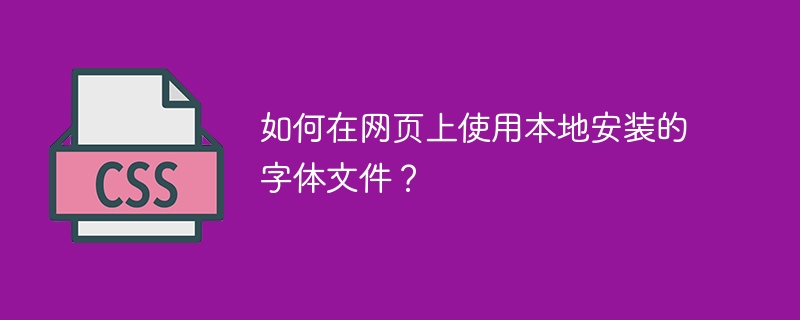How to use locally installed font files on web pages?

Apply local installed fonts in web pages
In web design, you may want to use a specific font that is already installed in the system, but using the font name directly in CSS does not work. This article will demonstrate how to correctly call locally installed fonts in a webpage.
Problem: Local fonts cannot be displayed in web pages
Suppose you have installed the font "Jingnan Mai Round" but the CSS code:
html, body {
font-size: 18px;
font-family: "Jingnan Mai Round Body", "Microsoft Yahei", "Helvetica Neue", Helvetica, Arial, sans-serif;
} Still displaying "Microsoft Yahei" instead of "Jingnan Mai Round Body". You don't want to load font files through src attribute because the font files are large in size.
Solution: Use @font-face rules
The key to solving this problem is to use the @font-face rule, which allows you to define custom fonts and apply them to web page elements. Since you want to use locally installed fonts, there is no need to specify the src path. The browser will automatically find and use the fonts installed on the system.
The correct CSS code is as follows:
@font-face {
font-family: 'JingNanMaiYuanTi'; /* Define the font name, it is recommended to use the English name*/
}
html, body {
font-size: 18px;
font-family: 'JingNanMaiYuanTi', "Microsoft Yahei", "Helvetica Neue", Helvetica, Arial, sans-serif;
}The key is:
- Define font name: Define an easily recognizable font name (such as English name) in the
@font-facerule to avoid the compatibility issues that may arise from Chinese names. - Use Font Name: Use the font name defined in step 1 in
font-familyproperty. The browser will prioritize finding the font corresponding to this name. If not found, alternative fonts are used in turn.
After modifying the CSS code, if it still fails to display, try refreshing the browser cache or restarting the browser. Make sure your operating system is properly installed and enabled.
The above is the detailed content of How to use locally installed font files on web pages?. For more information, please follow other related articles on the PHP Chinese website!

Hot AI Tools

Undresser.AI Undress
AI-powered app for creating realistic nude photos

AI Clothes Remover
Online AI tool for removing clothes from photos.

Undress AI Tool
Undress images for free

Clothoff.io
AI clothes remover

AI Hentai Generator
Generate AI Hentai for free.

Hot Article

Hot Tools

Notepad++7.3.1
Easy-to-use and free code editor

SublimeText3 Chinese version
Chinese version, very easy to use

Zend Studio 13.0.1
Powerful PHP integrated development environment

Dreamweaver CS6
Visual web development tools

SublimeText3 Mac version
God-level code editing software (SublimeText3)

Hot Topics
 1359
1359
 52
52
 How to use bootstrap button
Apr 07, 2025 pm 03:09 PM
How to use bootstrap button
Apr 07, 2025 pm 03:09 PM
How to use the Bootstrap button? Introduce Bootstrap CSS to create button elements and add Bootstrap button class to add button text
 How to insert pictures on bootstrap
Apr 07, 2025 pm 03:30 PM
How to insert pictures on bootstrap
Apr 07, 2025 pm 03:30 PM
There are several ways to insert images in Bootstrap: insert images directly, using the HTML img tag. With the Bootstrap image component, you can provide responsive images and more styles. Set the image size, use the img-fluid class to make the image adaptable. Set the border, using the img-bordered class. Set the rounded corners and use the img-rounded class. Set the shadow, use the shadow class. Resize and position the image, using CSS style. Using the background image, use the background-image CSS property.
 How to resize bootstrap
Apr 07, 2025 pm 03:18 PM
How to resize bootstrap
Apr 07, 2025 pm 03:18 PM
To adjust the size of elements in Bootstrap, you can use the dimension class, which includes: adjusting width: .col-, .w-, .mw-adjust height: .h-, .min-h-, .max-h-
 How to layout bootstrap
Apr 07, 2025 pm 02:24 PM
How to layout bootstrap
Apr 07, 2025 pm 02:24 PM
To use Bootstrap to layout a website, you need to use a grid system to divide the page into containers, rows, and columns. First add the container, then add the rows in it, add the columns within the row, and finally add the content in the column. Bootstrap's responsive layout function automatically adjusts the layout according to breakpoints (xs, sm, md, lg, xl). Different layouts under different screen sizes can be achieved by using responsive classes.
 How to verify bootstrap date
Apr 07, 2025 pm 03:06 PM
How to verify bootstrap date
Apr 07, 2025 pm 03:06 PM
To verify dates in Bootstrap, follow these steps: Introduce the required scripts and styles; initialize the date selector component; set the data-bv-date attribute to enable verification; configure verification rules (such as date formats, error messages, etc.); integrate the Bootstrap verification framework and automatically verify date input when form is submitted.
 How to set the bootstrap navigation bar
Apr 07, 2025 pm 01:51 PM
How to set the bootstrap navigation bar
Apr 07, 2025 pm 01:51 PM
Bootstrap provides a simple guide to setting up navigation bars: Introducing the Bootstrap library to create navigation bar containers Add brand identity Create navigation links Add other elements (optional) Adjust styles (optional)
 How to view the date of bootstrap
Apr 07, 2025 pm 03:03 PM
How to view the date of bootstrap
Apr 07, 2025 pm 03:03 PM
Answer: You can use the date picker component of Bootstrap to view dates in the page. Steps: Introduce the Bootstrap framework. Create a date selector input box in HTML. Bootstrap will automatically add styles to the selector. Use JavaScript to get the selected date.
 How to write split lines on bootstrap
Apr 07, 2025 pm 03:12 PM
How to write split lines on bootstrap
Apr 07, 2025 pm 03:12 PM
There are two ways to create a Bootstrap split line: using the tag, which creates a horizontal split line. Use the CSS border property to create custom style split lines.




